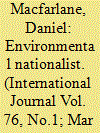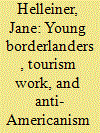| Srl | Item |
| 1 |
ID:
178327


|
|
|
|
|
| Summary/Abstract |
Prior to 1945, General Andrew George Latta McNaughton had already made a name for himself as an army general, engineer, inventor, and cabinet minister. After 1945, McNaughton occupied a number of key international roles for Canada: at the United Nations, on the Permanent Joint Board on Defence, and on the International Joint Commission. Even though he became one of Canada’s most important diplomatic actors during the early Cold War period, this aspect of his career has been mostly ignored by international historians. This article examines McNaughton’s key involvement in the evolution of a number of Canada–US water megaprojects, arguing that his nationalism underpinned his approach to bilateral relations, which combined deep technical expertise with a willingness to publicly assert the Canadian national interest. McNaughton’s approach should be studied not only to better understand North American environmental diplomacy in the Cold War but also to draw from it several lessons for contemporary times.
|
|
|
|
|
|
|
|
|
|
|
|
|
|
|
|
| 2 |
ID:
128023


|
|
|
|
|
| Publication |
2014.
|
| Summary/Abstract |
Niagara Falls and the Niagara River have always attracted great public interest due to their natural beauty, their enormous potential for electricity generation, their recreational value and as an important ecosystem. There have been simultaneous efforts to preserve this unique natural wonder and harness its power through hydroelectric development projects by both the United States and Canada. This paper explores the evolution of these efforts that culminated with the signing of the 1950 Niagara River Water Diversion Treaty that established minimum water flow rates to protect the "scenic beauty" of the falls, allowing the remaining water to be diverted for power production. We examine the rationale that led to specific water flow restrictions and question to what extent they are relevant today, as water intake capacity on the Canadian side has just been extended by around 25%. We find that current restrictions under the Niagara River Water Treaty (that expired in 2000) are not based on sound scientific evidence and estimate the upper limit of potential foregone benefits from clean electricity generation and greenhouse gas reductions. We identify a number of important issues that emerged in the last decades and that would justify an exploration of new treaty rules.
|
|
|
|
|
|
|
|
|
|
|
|
|
|
|
|
| 3 |
ID:
090600


|
|
|
|
|
| Publication |
2009.
|
| Summary/Abstract |
This article analyzes local engagements with tourism at the Canadian Niagara border. While regional elites promote cross-border tourism as part of a wider project of economic restructuring, interviews conducted with young Canadian borderlanders reveal critiques of tourism-related work and expressions of anti-Americanism. Young borderlanders' experiences and identities, I argue, have wider implications for regional and continental projects of integration and securitization in a changing North American political economy.
|
|
|
|
|
|
|
|
|
|
|
|
|
|
|
|